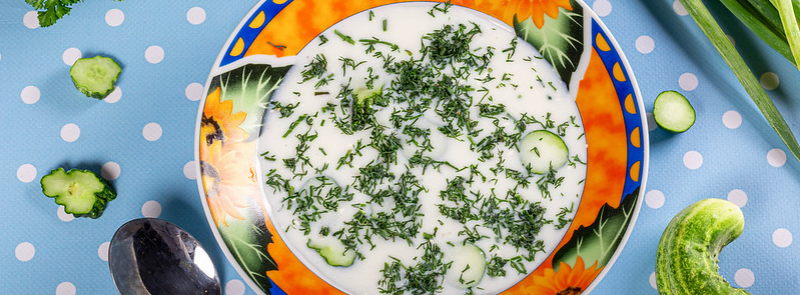
When It Occurs
Every May 30th
Timeline
Days Passed (328)
# Hashtags
#OkroshkaDay #RussianSummerDish
Okroshka, a popular summer dish in Russia and neighboring countries, has inspired the creation of an informal celebration known as Okroshka Day, observed annually on May 30. While the exact origins remain unclear, this ambiguity doesn't hinder the enthusiasm for honoring the beloved cold soup.
Okroshka is thought to have evolved from botvinya, a cold soup featuring boiled and strained leafy vegetables along with sour kvass (a fermented beverage made from rye bread). Traditionally, botvinya was served with salmon or crayfish tails. The earliest botvinya recipe can be traced back to Domostroy (Domestic Order), a 16th-century collection of household rules, instructions, and advice.
History and Background
- Origins: Okroshka is a traditional Russian soup that dates back centuries. The name "okroshka" comes from the Russian word "kroshit," which means to crumble or chop, reflecting the dish's preparation method. The soup is typically enjoyed in the warmer months as it is served cold and is very refreshing.
- Purpose: Okroshka Day celebrates this beloved Russian dish, encouraging people to prepare and enjoy it, especially during the hot summer days. It also serves to promote Russian culinary traditions and the enjoyment of seasonal, fresh ingredients.
What is Okroshka?
Okroshka is a cold soup that combines raw vegetables, boiled potatoes, eggs, and a cooked meat such as beef, veal, sausages, or ham. The mixture is then typically topped with a refreshing kvass or kefir-based broth. Here are the main ingredients commonly found in okroshka:
- Vegetables: Cucumbers, radishes, and spring onions are common.
- Protein: Boiled potatoes, eggs, and cooked meats (like beef, veal, sausages, or ham).
- Herbs: Fresh dill and parsley for flavor.
- Liquid Base: Kvass (a traditional Russian fermented beverage made from rye bread) or kefir (a fermented milk drink) are typically used as the soup base.
- Additional Ingredients: Sour cream or mustard may be added for extra flavor.
Types of Okroshka
- Kvass-Based Okroshka: The most traditional form, using kvass as the liquid base, giving it a tangy and slightly sweet flavor.
- Kefir-Based Okroshka: A more modern version that uses kefir, which provides a creamy texture and a slightly sour taste.
- Mineral Water-Based Okroshka: Some variations use sparkling mineral water with added lemon juice for a light and refreshing twist.
- Vegetarian Okroshka: Made without meat, using additional vegetables or legumes for protein.
Celebrations and Activities
Okroshka Day can be celebrated through various activities that highlight the dish and its cultural significance:
- Cooking Demonstrations: Chefs and food enthusiasts can host cooking demonstrations to teach others how to prepare traditional okroshka.
- Family Gatherings: Families can come together to make and enjoy okroshka, sharing recipes and enjoying the refreshing meal.
- Food Festivals: Local food festivals or markets may feature okroshka tasting events and competitions.
- Social Media Campaigns: Sharing photos, recipes, and videos of okroshka preparations on social media using hashtags like #OkroshkaDay and #RussianCuisine.
- Restaurant Specials: Restaurants may offer okroshka specials or themed menus to celebrate the day.
How to Prepare Traditional Okroshka
-
Ingredients:
- 2-3 boiled potatoes
- 2-3 hard-boiled eggs
- 200 grams of cooked meat (beef, veal, sausages, or ham)
- 2-3 fresh cucumbers
- 5-6 radishes
- 3-4 spring onions
- Fresh dill and parsley
- 1 liter of kvass or kefir
- Sour cream (optional)
- Salt and pepper to taste
-
Instructions:
- Chop Ingredients: Dice the boiled potatoes, eggs, meat, cucumbers, and radishes into small pieces. Finely chop the spring onions and herbs.
- Combine: In a large bowl, combine all the chopped ingredients.
- Add Liquid: Pour the kvass or kefir over the mixture until it is fully covered. Mix well.
- Season: Add salt and pepper to taste. Optionally, stir in a spoonful of sour cream for extra creaminess.
- Chill: Refrigerate the okroshka for at least an hour before serving to allow the flavors to meld and the soup to chill thoroughly.
- Serve: Serve the okroshka cold, garnished with additional fresh herbs if desired.
Significance of Okroshka Day
Okroshka Day is a celebration of Russian culinary heritage and the enjoyment of a traditional, refreshing dish that is perfect for summer. It promotes the use of fresh, seasonal ingredients and highlights the cultural significance of okroshka in Russian cuisine.
By celebrating Okroshka Day, people can connect with cultural traditions, enjoy a healthy and delicious meal, and share the experience with friends and family. It also serves as an opportunity to explore the diversity of Russian cuisine and appreciate the culinary traditions that have been passed down through generations.


